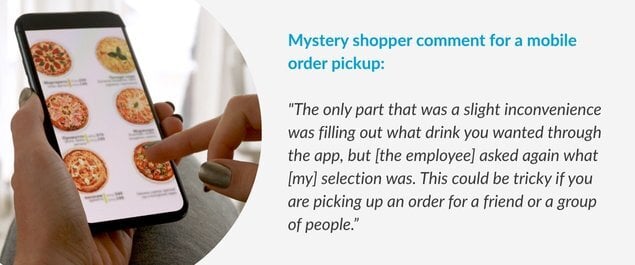What Online Mystery Shopping Reveals About Your Digital CX
Thousands of customers visit you online every day. Some can’t find what they need. Others hit errors, confusing apps, or unclear support loops. Many...

Quick service brands run on precision. Every moment counts, whether it’s a mobile order, a drive-thru handoff, or an in-store interaction. Customers are the ultimate judge of the experience, and their perceptions are often shaped by nuanced moments.
Mystery shopping helps QSR operators see the guest experience the way they actually live it. By evaluating real interactions across all service channels, brands can pinpoint where execution falls short, where it shines, and how those details shape loyalty and satisfaction. The result is a clear roadmap for faster service, stronger training, and higher customer satisfaction.
There are two types of programs used to measure operational execution. The first is Mystery Shopping, where trained shoppers covertly evaluate the customer experience they receive. The second is an Operational Audit, where third-party auditors perform an overt assessment, meaning staff are aware of their presence and can be evaluated on elements customers would not normally see. For this blog, we are focused on the first approach: Mystery Shopping Audits, which capture the guest experience exactly as it happens.
Below are seven mystery shopping audit programs designed specifically for QSRs that translate day-to-day execution into business growth.
With almost 75% of restaurant traffic now generated off-premises, the drive-thru remains one of the most critical touchpoints for QSRs. Customers expect speed, accuracy, and friendliness, all within minutes. Mystery shopping audits measure how these elements perform under real conditions, showing brands exactly how each interaction plays out from the customer’s seat. For instance, our latest Drive-Thru Study based on mystery shopper insights, not needing to repeat orders at the lane saved an average of 1 minute and 25 seconds per transaction. The same research revealed clear brand-by-brand differences in service speed and order precision.
When conducted consistently, drive-thru audits give operators measurable insights into queue management, staff efficiency, and service consistency. The data reveals where operations run smoothly and where delays or miscommunication impact the experience.
A few potential focus areas for this audit:
The findings help operators remove friction, improve training, and make decisions that directly impact satisfaction and repeat visits.
As digital ordering grows, consistency across platforms becomes essential. Mystery shopping audits of mobile, web, curbside, and pickup channels evaluate how customers experience convenience across your digital ecosystem. Our Emerging Experience Study discovered that 22% of shoppers who placed a mobile order didn’t know where to go for pickup, with 91% stating the instructions were unclear.
These audits identify whether customers encounter friction during ordering, unclear pickup instructions, or delays between confirmation and readiness. By simulating real digital journeys, QSR brands can see if their tech-driven convenience translates into real-world satisfaction.
Some key elements mystery shoppers may assess:
The results help brands refine digital workflows and ensure a seamless omnichannel experience from tap to table.

Delivery has become one of the strongest growth channels for QSRs. It also brings new challenges to brand perception, especially when delivery partners are involved. Mystery shopping audits evaluate the entire delivery journey from the customer’s perspective across both first-party systems and third-party marketplaces. These audits measure whether customers receive their food on time, at the right temperature, and in the expected condition, which directly influences overall satisfaction.
In our 2025 Third-Party Delivery Study, based on data from 600 mystery shopping audits, we analyzed how the two systems differ in customer experience. One of the findings showed that first-party applications offered 7% higher order customization ability compared to third-party apps.
Intouch Insight’s mystery shopping service, IntouchShop®, also gave insights into metrics comparisons of QSRs vs. C-Stores in food delivery, revealing vital competitive stats for the industry.
A snapshot of what this program could cover:
By auditing both owned and partner delivery channels, brands gain visibility into areas that directly influence satisfaction, ratings, and retention.

In-person dining still defines how guests connect emotionally with your brand. Mystery shopping audits evaluate everything customers see and feel during their visit, from the initial greeting to the cleanliness of the dining area.
These programs capture how staff manage busy periods, handle orders, and deliver food presentation that reflects brand standards. The insights show operators how the human side of service contributes to loyalty and long-term value. For example, our mystery shopper insights revealed that dine-in customer satisfaction was 99% when service was friendly compared to 56% when it was not.
Some areas typically reviewed in this audit:
Well-executed counter and on-premises audits provide clarity on where service training and operational improvements can make the biggest impact.
Automation is transforming how customers order, but new tools only work if they create a smoother experience. Mystery shopping programs for kiosks and voice-AI ordering journeys test how intuitive, efficient, and reliable these systems are in real-world conditions.
To evaluate QSR innovations, shoppers interact with your technology as a customer would: navigating menus, customizing orders, and checking whether staff respond quickly when support is needed. These audits help confirm that automation enhances speed without sacrificing connection. From our mystery shopper observations, service times were 21 seconds faster at AI-enabled lanes compared to traditional lanes.
A few areas this audit might explore:
Given that brands are testing technologies like voice AI ordering to address rising labor costs and staffing shortages, these mystery shopping insights help determine whether those tools reduce friction and build customer confidence in new technology.
Find out if a Voice AI Drive-Thru can become your best order taker.
Mystery shopping audits that focus on loyalty and promotions help measure how well front-line teams turn transactions into relationships. Shoppers evaluate how consistently staff promote loyalty programs, apply offers, and execute limited-time offers.
These audits connect marketing strategy to real guest behavior. When done regularly, they reveal how well staff drive engagement and whether campaigns translate to customer participation and sales. Through IntouchShop® mystery shopping services, we discovered that 95% of kiosk shoppers were offered a suggestive sale compared to just 75% at the counter.
A few examples of what this audit could include:
A strong QSR brand is built on consistent execution. Core compliance mystery shopping audits evaluate the visible details that define trust: cleanliness, presentation, and product quality.
Mystery shoppers observe what customers experience in real time, from spotless counters to correctly presented meals. These insights show how well locations maintain brand standards under everyday pressure. And with 70% of shoppers saying that a clean store shapes how fresh they think the food is, these audits can make or break how customers perceive a QSR the moment they walk in.
Some potential focus areas for this audit:
High compliance performance strengthens customer confidence and helps maintain brand integrity across every location.
Mystery shopping audits give QSR operators more than data, they give them perspective. Each program captures the customer experience as it happens, turning real interactions into actionable insights.
When brands measure what customers truly experience, improvement becomes intentional. From faster drive-thrus to stronger loyalty engagement, mystery shopping audits transform everyday execution into lasting growth.
Request a quote for you very own IntouchShop® mystery shopping program.

Thousands of customers visit you online every day. Some can’t find what they need. Others hit errors, confusing apps, or unclear support loops. Many...

On a routine store visit, Maya, an operations manager, noticed something she couldn’t explain. Her store was running smoothly, the team was engaged,...

Consistency is one of the hardest things to maintain in retail. Even with clear standards, two stores under the same brand can feel completely...